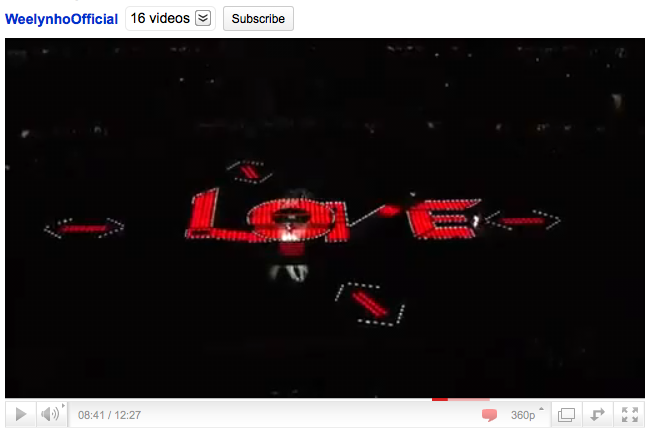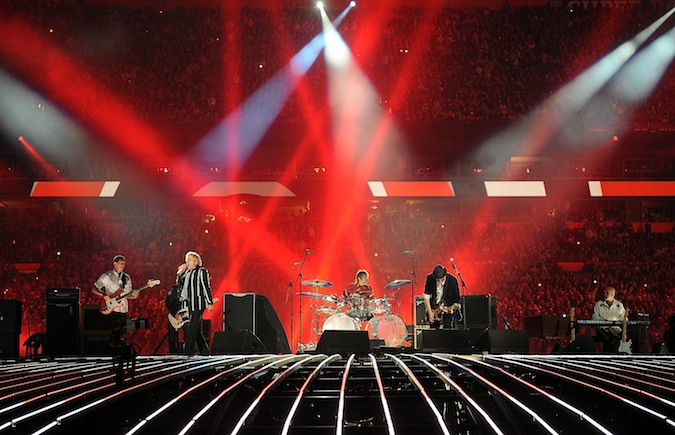Super Bowl XLV Halftime Show: Missing Lights?

The biggest sporting event in the United States is over… ALL HAIL THE PACKERS! Yes, I am a packers fan, if you didn’t know. Boy oh boy do I wish I was back in the home land right now. I hear Wisconsin is going crazy! So did you survive the game? I personally had a great time with the wife and some friends and an adorable English Bulldog named Reba!
Let’s talk about the halftime show as I am sure that is what many of us professionals were MOST interested in. What did you think? Overall, I liked the production value, but of course, the audio was a “bit off”. Not blaming our soundie friends, I think it was more of Fox’s problem. One thing that stood out was when the staging came together to form LOVE about 9 minutes into the show. Did anyone else notice it… Some of the V not being lite up?
Of course as a lighting person, my friends immediately hounded me about what happened… I am not quite sure, but it could be a number of things. Someone didn’t plug something in, a wireless DMX signal was lost. Those are just a couple of my guesses of the top of my head. What do you think happened? Love to hear what you think in the comments section of this post.
You can see the entire half time show on YouTube. The screen shot from above is at about 8:41 into that particular video which is embedded below.
PRG & the Super Bowl Halftime Show

Photo credit: Gustavo Caballero / Getty Images Entertainment
More and more Press Releases are rolling in from this years Super Bowl Halftime Show. Again, this is something I normally do not write about he. But this years Super Bowl Halftime Show featuring The Who was spectacular! If you watched the Halftime Show, I am sure you were like me and wondered how they put this all together. PRG (Production Resource Group), just issued a Press Release that goes over some of the details that Lighting Designer, Al Gurdon did to create such a wonderful Halftime Show. More from the PRG Press Release:
When the legendary rock band The Who took the stage at the Sun Life Stadium in Miami, FL for the Bridgestone Super Bowl XLIV Halftime Show, it was the culmination of months of hard work and collaboration. “The Who is an iconic rock band known partly for a very distinctive and recognizable visual style,” commented Lighting Designer Al Gurdon. “There is a pre-existing visual ‘vocabulary’, which can inform and support the design approach.” Production Resource Group (PRG) provided the lighting package and crew for the Halftime show, one of the most intense twelve minutes in live entertainment.
Gurdon, Production Designer Bruce Rodgers and Screens/Graphics Producer Lee Lodge collaborated on the NFL Network Production with executive producer Ricky Kirshner and director Hamish Hamilton, translating that vocabulary into an integrated, cutting-edge design. “I wanted to develop the visual impact of the stage floor itself, and extend that out into the audience in a three-dimensional way,” Gurdon explained. “I wanted to create a background for camera close-ups and have the audience and the stadium itself be part of the spectacle and the set.”
Gurdon’s lighting programmer for the event was industry veteran Michael “Oz” Owen. Due to the severely limited rehearsal time on-site, Gurdon and Owen spent five days at PRG Essential Lighting’s pre-visualization studio in London, programming the show. Owen also worked with Video Content Programmer Jason Rudolph to insure that the lighting and the LEDs in the stage floor were completely synchronized. Owen and Rudolph both used PRG’s Virtuoso® control consoles. “I always prefer using a Virtuoso,” Owen said. “In Miami, I had three; one in the band/stage rehearsal tent, one in the ‘design’ cabin and one front of house. With PRG, I feel really comfortable because there is always plenty of support.”
Rudolph added, “I used the Virtuoso because it made it so easy for Oz and I to sync our cue lists. He could export his cue timings, and I could import them directly into my show and edit them as needed.” PRG also engineered a HTP (Highest Takes Precedence) data merge for the lighting and the video systems. “The merge,” explained Rudolph, “was there so that we could control the color blocks either via the media server doing pixel-mapping, or from Oz’s Virtuoso console. It gave us more programming options.
In addition to Gurdon and Owen, the lighting team included Lighting Directors Rich Gorrod, Bob Barnhart and David Grill. Peter Radice provided additional lighting programming. Full Flood Inc. coordinated with PRG on the lighting equipment and crew. The PRG technicians supervised the volunteers who were responsible for setting up the lighting on the field. Several members of the PRG crew have participated in as many as ten Halftime shows.
Gurdon was very pleased with the results. “We had a very good rig, with no reliability problems at all. You need to know you can rely on things working. PRG was great; I work with them all the time and I find they provide great service and great crews. I always know PRG will deliver; I couldn’t ask for more from them.”
XL Video and the Super Bowl XLIV Halftime Show

2010 Getty Images/Doug Benc
XL Video just put out a Press Release with more detailed information about how the Super Bowl XLIV Halftime Show came together. While I normally do not post about installations and events, this one is hard to pass up. If you watched the Halftime show this year and are into lighting and are like me, you were in aw of the performance. The press release gives some good insight into what was used and how it all came together. More from the press release:
How do you design a 12-minute Halftime show for The Who, one of the most iconic rock bands in the world? You push the envelope on what’s possible and exceed expectations by putting together a visual spectacle integrating LED video technology, lighting, pyro and lasers. To pull off The Bridgestone Super Bowl XLIV Halftime Show at Sun Life Stadium in Miami, described as the most intense 12-minutes in live entertainment, it takes a team effort and XL Video was proud to support the creative team by supplying gear and crew. Production Designer Bruce Rodgers, Screens/Graphics Producer Lee Lodge and Lighting Designer Al Gurdon closely collaborated on the NFL Network Production with Executive Producer Ricky Kirshner and Director Hamish Hamilton to present an unforgettable performance. “We wanted a design that felt epic; we wanted a design that felt like the band was performing for the stadium and not just the TV audience,” explained Rodgers.
Of course achieving an epic spectacle means taking a tremendous risk, especially when it is a live performance in front of thousands in attendance and millions of TV viewers. Rodgers designed a field-wide circular stage with over 3,000 Barco MiSTRIPs. “I came up with this idea to put the band on what I refer to as Captain America’s shield made out of video,” described Rodgers. “The floor is made up of 26 radial sections that surround a main stage that is made of 14-pieces.” Essentially creating a 40-piece jigsaw puzzle that 600 volunteers and crew had less than eight-minutes to move onto the field, setup, power up and go live. “It was a real example of our industry at its best; needing everybody to work together to make something big happen. All the planning, designing and meticulous attention to detail really paid off.”
For the actual video ‘shield’ Rodgers turned to XL Video to help engineer and supply 3,055 five-foot long LED MiSTRIPs, processing as well as for technical support during not only the installation but show itself. “I wanted a technology that would be nice, bright and controllable as well as weatherproof. I designed the MiSTRIP radiating from the outside going towards the middle on nine-inch centers. I worked closely with the XL team from the very beginning,” noted Rodgers. “I needed an immense amount of equipment but I also needed a completely reliable company. With XL, I could say to Ricky, ‘I have the same video company that we worked with for the Democratic National Convention. They have the technology and we know that they can make it happen.’ And they certainly did.”
XL and Rodgers did testing to confirm the choice of the MiSTRIPs and to ensure the best approach for mounting them to the stage carts as well as how to deal with the processing requirements on a sectional mobile stage. XL and Rodgers knew the most enormous challenge was the fact that the stage broke apart into 40-pieces. In order to handle the need to keep many of the most critical components powered up, XL used uninterruptible power supplies. In the staging locations, they had 110V power drops, where they would connect the UPS units to keep the batteries charged. Once the stage was brought together they had 109 connections to make for the video components alone. A daunting task in less than eight-minutes. “The goal was eight minutes; we did it in seven and a half minutes,” said Bob Magee, XL Video Account Executive and Project Manager for the Super Bowl.
There were 11 XL Video technicians underneath the stage to make connections as it was locked together. Each technician had responsibility for four carts each and XL Technical Director Mike Spencer oversaw everything in its entirety. Everybody knew each other’s role and responsibility so anybody could jump in. XL always builds in redundancy into its systems especially for live television so for a pressure-filled high-profile event like the Halftime show they had redundancy built in all the way down to the technician layer. Rodgers appreciated the coordinating planning XL put in. “All the technical guys from XL Video were like Navy Seals or ninjas. It was awesome.”
In addition to Magee and Spencer, the XL Video team included Ken Gay, XL Nashville and Lead Technician Luke Pilato. Technicians from both the LA and Atlanta XL offices included Trace Deroy; Doug Eldredge; David Imlau; Fernando Llamas; Curtis Luxton; Will Nazarowski; Steve Otten; Eric Petty; and Rod Silhanek.
Another tool XL Video supplied to both Rodgers and Lodge was the UVA d3 Show Production Suite. The d3 was used to assist in the media development and the visualization process. It helped Rodgers and Lodge present their design vision to the NFL, Kirshner and Hamilton. “We used the d3 system as a visualization tool. I often like using d3 as a communication tool,” pointed out Lodge. “It is good for the director, in this case Hamish, to see his camera angles in terms how various shots were going to work. Also it is a very good way rather than just showing a top shot; it is a really good tool to communicate a project to a client. Because we had very limited time on site we obviously did a lot of pre-visualization. I think that whole pre-viz time and understanding the template was crucial to this project.”
From demanding design to exacting execution, Rodgers and Lodge presented XL Video with one of their most challenging projects. “XL Video was exemplary really,” commented Lodge. “On this sort of project, with the amount of work that XL was doing; the amount of discussion and detail it needed communication and trust. For me, if XL is on the job, then I am feeling very confident.”
Thanks XL Video for the press release!
LatestHeadlines
- Upgrading Your Toolbox: City Theatrical DMXcat-E and DMXcat Multi Function Test Tool
- Claypaky Bringing Back the Sexy to Par Cans with the Midi-B FX
- Ayrton Evolves the Cobra, the Cobra2 Developed for the US Market
- MA Lighting Intros grandMA3 onPC Fader Wing and DIN-Rail Nodes
- Live Events LEVL Up Fest: A Festival to Aid our Industry